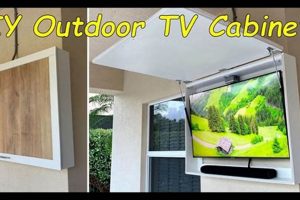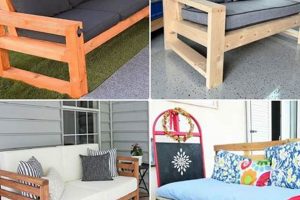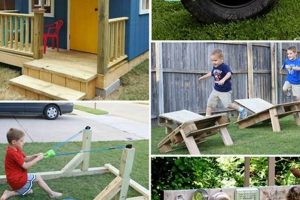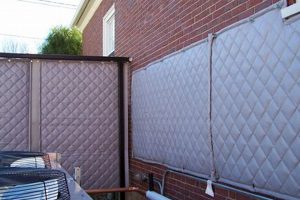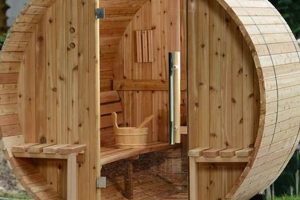An outdoor cooking and food preparation area, constructed affordably by the homeowner, represents a cost-effective alternative to professionally built installations. These spaces often incorporate reclaimed materials, repurposed furniture, and simplified designs to minimize expenses. For example, a basic setup might involve a brick barbecue pit combined with a repurposed wooden pallet transformed into a counter, all achieved with minimal financial investment.
Such constructions offer several advantages, including cost savings compared to professional installations and customization to suit individual needs and space constraints. Historically, outdoor cooking areas have been integral to social gatherings and food preparation, evolving from simple fire pits to elaborate structures, reflecting both cultural traditions and practical necessities. The ability to create such a space without significant financial outlay democratizes this aspect of home improvement and outdoor living.
The subsequent sections will delve into essential considerations for planning and executing a successful project of this nature, focusing on design ideas, material selection, and construction techniques. These aspects will explore methods to achieve functionality and aesthetics while adhering to budget limitations.
Tips for Economical Outdoor Cooking Area Construction
The creation of a functional and visually appealing outdoor cooking area need not require substantial financial resources. Prudent planning and resourcefulness are key to maximizing value and minimizing expenses. The following tips offer practical guidance for constructing an effective and affordable space.
Tip 1: Prioritize Functionality over Complexity: Focus on essential features such as a cooking surface, workspace, and storage. Avoid elaborate designs that necessitate specialized materials or labor.
Tip 2: Embrace Reclaimed and Repurposed Materials: Sourcing materials from demolition sites, online marketplaces, or local salvage yards can significantly reduce costs. Used bricks, reclaimed lumber, and repurposed metal sheeting offer viable alternatives to new materials.
Tip 3: Design a Simple and Efficient Layout: An efficient layout minimizes the need for extensive plumbing or electrical work. Consider proximity to existing utilities to reduce installation costs.
Tip 4: Opt for Cost-Effective Cooking Solutions: A simple charcoal grill or a DIY brick barbecue pit is a far more economical choice than high-end gas grills or built-in smokers.
Tip 5: Build incrementally: Undertake the project in phases, prioritizing the most essential elements initially. This allows for a more manageable budget and permits adjustments based on experience and evolving needs.
Tip 6: Leverage Online Resources and Tutorials: Numerous online resources and tutorials provide step-by-step guidance on DIY construction techniques. These resources can save on professional consultation fees and offer practical solutions to common challenges.
Tip 7: Consider Weather Protection Economically: A simple awning or pergola constructed from inexpensive materials can provide protection from the elements without significant cost.
These tips emphasize the importance of planning, resourcefulness, and a pragmatic approach to construction. By prioritizing functionality, embracing repurposed materials, and leveraging available resources, a homeowner can create an enjoyable and functional outdoor cooking area without exceeding budget limitations.
The concluding section will summarize the key considerations and offer final thoughts on the successful implementation of a cost-effective construction project.
1. Budget-conscious planning
Budget-conscious planning serves as the foundational element for any successful endeavor centered around affordable, do-it-yourself outdoor cooking areas. Without meticulous financial forecasting and resource allocation, a project intended to be economical can easily escalate in cost, negating the primary objective. The effects of inadequate planning can manifest as overspending on materials, inefficient use of resources, and ultimately, an unfinished or substandard construction. For instance, overlooking the cost of necessary tools or failing to account for potential waste of materials can significantly impact the total project expenditure. Consider the scenario where a homeowner impulsively purchases lumber without comparing prices at different suppliers; this lack of planning could result in paying a premium for a readily available, yet overpriced, resource.
The importance of budget-conscious planning lies in its ability to provide a clear roadmap for the entire project, enabling informed decision-making at every stage. It allows for the prioritization of essential features, the selection of cost-effective materials, and the identification of potential cost-saving measures. A practical application of this principle involves creating a detailed inventory of existing resources and determining which materials can be salvaged or repurposed, thereby reducing the need for new purchases. Furthermore, thorough research into various construction techniques and material options allows for the selection of the most economical approach without compromising structural integrity or aesthetic appeal. For example, opting for a gravel base instead of a concrete slab for the flooring can represent a substantial cost saving, provided the site is adequately prepared and the gravel is properly compacted.
In conclusion, budget-conscious planning is not merely a preliminary step but an ongoing process that permeates every aspect of constructing an affordable, DIY outdoor cooking area. Its absence can lead to financial overruns and compromised outcomes. By embracing meticulous planning, resourcefulness, and a commitment to cost-effective solutions, a homeowner can successfully create a functional and aesthetically pleasing outdoor space without exceeding financial limitations. The challenges often associated with such projects can be effectively mitigated through careful planning, resulting in a rewarding and economically sound investment.
2. Repurposed material use
Repurposed material use constitutes a cornerstone strategy in the construction of affordable, do-it-yourself outdoor cooking areas. The intelligent application of reclaimed and repurposed resources provides a tangible pathway to cost reduction, while simultaneously promoting environmentally conscious construction practices. The following facets illustrate the practical dimensions of this approach.
- Reduction of Raw Material Expenditures
The reliance on reclaimed materials directly mitigates the need to purchase new lumber, brick, or metal. For example, salvaged bricks from demolition sites can be used to construct a barbecue pit, while reclaimed lumber from construction projects can serve as countertop material. This substitution significantly lowers the overall expense of the project, diverting materials from landfills and contributing to resource conservation.
- Enhanced Design Aesthetics and Character
Repurposed materials often possess unique textures, patinas, and historical characteristics that impart a distinctive aesthetic to the outdoor cooking area. Weathered wood, for instance, can introduce a rustic charm that is difficult to replicate with new materials. The inherent individuality of these materials transforms the space from a purely functional area into a visually interesting and personalized outdoor environment.
- Mitigation of Environmental Impact
By utilizing repurposed materials, the demand for newly manufactured products decreases, thereby reducing the energy consumption and pollution associated with resource extraction and processing. This sustainable approach aligns with environmentally responsible building practices and minimizes the carbon footprint of the project. Examples include using reclaimed metal for shelving units or repurposing old tires for planters around the perimeter.
- Creative Problem Solving and Adaptability
Working with repurposed materials often necessitates creative problem-solving and adaptability. The dimensions and characteristics of reclaimed resources may not perfectly align with the original design, requiring adjustments and innovative solutions. This constraint can foster ingenuity and lead to unique and functional design elements that would not have been considered with standard materials. An example might involve adapting the size of a countertop to fit the specific dimensions of a salvaged piece of lumber.
In essence, the adoption of repurposed material use extends beyond mere cost-saving measures. It embodies a commitment to sustainability, creativity, and the creation of distinctive outdoor spaces. The successful integration of these materials requires careful planning, thoughtful design, and a willingness to embrace the unique characteristics of each salvaged resource, solidifying its pivotal role in realizing affordable and aesthetically appealing outdoor cooking areas.
3. Simplified design
The principle of simplified design is integral to achieving an affordable, do-it-yourself outdoor cooking area. Complexity in design often translates directly to increased material costs, specialized labor requirements, and prolonged construction timelines, all of which undermine the goal of an inexpensive project. By embracing simplicity, the homeowner can mitigate these factors and realize a functional and aesthetically pleasing outdoor space without significant financial investment.
- Reduction of Material Waste
Simplified designs typically involve fewer intricate cuts and complex joinery techniques. This reduction in complexity minimizes material waste, as there are fewer opportunities for errors that lead to unusable pieces. For example, a straightforward rectangular countertop design will generate less waste than a curved or multi-angled design, allowing for more efficient utilization of lumber.
- Lowered Labor Requirements
Projects with simplified designs can often be executed by individuals with limited construction experience. The absence of complex features reduces the need for specialized skills or professional assistance, allowing the homeowner to undertake the majority of the work independently. This self-sufficiency translates to significant cost savings by eliminating or minimizing labor expenses.
- Increased Use of Standard Materials
Simple designs tend to incorporate readily available and inexpensive standard-sized materials. Rather than requiring custom cuts or specialized components, the design can be adapted to accommodate commonly available lumber dimensions, brick sizes, or metal sheeting. This adaptability reduces the need for custom orders or specialized sourcing, further minimizing project costs.
- Facilitated Incremental Construction
A simplified design allows for a more manageable and phased approach to construction. The homeowner can prioritize essential features and build incrementally, rather than attempting a large, complex project all at once. This phased approach allows for better budget control and reduces the risk of overwhelming the homeowner with the scope of the undertaking.
The adoption of simplified design principles is not merely about cost reduction; it is about creating a practical and functional outdoor cooking area that is accessible to a wider range of individuals, regardless of their construction experience or financial resources. By prioritizing simplicity, the homeowner can focus on the core elements of an outdoor cooking space, such as a functional cooking surface, adequate workspace, and sufficient storage, without becoming entangled in unnecessary complexity or exorbitant expenses.
4. Multifunctional elements
The integration of multifunctional elements is a critical strategy for achieving cost-effectiveness in do-it-yourself outdoor cooking spaces. By maximizing the utility of each component, the overall material and labor requirements are reduced, directly contributing to budget adherence. The following details the specific attributes of this approach.
- Combined Cooking and Preparation Surfaces
A single countertop can serve as both a preparation area and a surface for supporting cooking appliances such as portable grills or griddles. This eliminates the need for separate, dedicated surfaces, thereby reducing material costs and space requirements. An example includes a concrete countertop with integrated heat-resistant tiles for supporting a portable charcoal grill, while the remaining surface is used for food preparation.
- Dual-Purpose Seating and Storage
Benches with integrated storage compartments offer seating while simultaneously providing space for storing cooking utensils, fuel, or outdoor dining essentials. This consolidation of function reduces the need for separate storage units, minimizing material costs and optimizing space utilization. A wooden bench with a hinged top, concealing storage for charcoal and grilling tools, exemplifies this concept.
- Modular and Adaptable Structures
Constructing modular components allows for reconfiguration and adaptation of the outdoor cooking area to suit different needs and occasions. A simple framework constructed from lumber can support a variety of inserts, such as shelving, drawers, or cooking appliance mounts, providing flexibility and minimizing the need for permanent, specialized structures. A framework that accommodates interchangeable shelves, drawers, and a small refrigerator represents this adaptability.
- Retractable or Fold-Away Features
Incorporating retractable or fold-away elements maximizes the usability of limited spaces. A fold-down countertop or a retractable serving surface can provide additional workspace when needed, while minimizing obstruction when not in use. This feature enhances the functionality of the space without significantly increasing material costs. A wall-mounted folding table that serves as a bar or preparation area embodies this principle.
The integration of multifunctional elements is not merely a matter of cost savings; it is a strategic approach to maximizing the efficiency and usability of limited outdoor spaces. By carefully considering the diverse needs of the homeowner and incorporating elements that serve multiple purposes, a functional and aesthetically pleasing outdoor cooking area can be achieved within budgetary constraints. The judicious application of these principles is essential for realizing a successful do-it-yourself project.
5. Durable construction
Durable construction is a paramount consideration in the realm of affordable, do-it-yourself outdoor cooking areas. While the initial objective may be to minimize expenses, neglecting structural integrity and longevity can result in increased costs in the long term due to repairs, replacements, and potential safety hazards. Consequently, a balance must be achieved between cost-effective material selection and sound construction practices to ensure a resilient and sustainable outdoor cooking space.
- Proper Foundation and Support
The foundation serves as the bedrock of any outdoor structure, and its stability directly impacts the durability of the entire cooking area. Even with inexpensive materials, a properly prepared and leveled foundation is crucial to prevent settling, cracking, and structural instability. For example, a gravel base, while less expensive than concrete, must be adequately compacted and reinforced to provide sufficient support for countertops, cooking appliances, and other heavy elements. Neglecting this aspect can lead to premature failure, necessitating costly repairs or reconstruction.
- Weather-Resistant Material Selection
Outdoor cooking areas are exposed to the elements, including rain, sun, wind, and temperature fluctuations. Therefore, the selection of weather-resistant materials is essential for ensuring long-term durability. While expensive hardwoods may be beyond the budget, treated lumber, pressure-treated plywood, and sealed concrete offer cost-effective alternatives that provide adequate protection against moisture, rot, and insect damage. The application of weather-resistant sealants and coatings is also critical for prolonging the lifespan of these materials.
- Robust Joinery and Fastening Techniques
The method of joining and fastening materials plays a significant role in the overall structural integrity of the outdoor cooking area. Employing appropriate fasteners, such as corrosion-resistant screws and bolts, and utilizing robust joinery techniques, such as mortise and tenon joints or properly reinforced butt joints, ensures that the structure can withstand stress and maintain its form over time. For instance, using galvanized screws instead of standard screws in exposed areas can prevent rust and maintain the strength of the connections.
- Protective Finishes and Maintenance
The application of protective finishes, such as sealants, stains, and paints, serves to shield the materials from environmental damage and prolong their lifespan. Regular maintenance, including cleaning, resealing, and prompt repair of any damage, is equally important for preserving the durability of the outdoor cooking area. For example, applying a UV-resistant sealant to wooden surfaces can prevent fading and cracking caused by prolonged sun exposure, extending the life of the wood and reducing the need for frequent refinishing.
In conclusion, durable construction is not an optional add-on but an integral component of any cost-effective, do-it-yourself outdoor cooking area. By prioritizing proper foundation preparation, selecting weather-resistant materials, employing robust joinery techniques, and implementing protective finishes and maintenance practices, the homeowner can create a resilient and long-lasting outdoor space that provides enjoyment and functionality for years to come. Balancing these considerations with budgetary constraints is the key to achieving a successful and sustainable project.
Frequently Asked Questions
The following section addresses common inquiries regarding the design, construction, and maintenance of outdoor cooking areas constructed on a limited budget. The answers provided aim to offer clarity and guidance for homeowners embarking on such projects.
Question 1: What constitutes the most significant cost-saving measure in an outdoor cooking area project?
The utilization of repurposed or reclaimed materials consistently offers the most substantial cost reduction. Sourcing materials from demolition sites, salvage yards, or online marketplaces can significantly lower expenses compared to purchasing new construction materials.
Question 2: Is it feasible to construct an outdoor cooking area without plumbing or electrical connections?
Indeed. A functional outdoor cooking area can be created without plumbing or electrical infrastructure. Utilizing portable water containers for washing and relying on propane or charcoal for cooking negates the need for costly utility installations.
Question 3: What materials offer the best balance of affordability and durability for outdoor countertops?
Poured concrete countertops represent a durable and relatively inexpensive option. Alternatively, sealed plywood or pressure-treated lumber, properly maintained, can provide a cost-effective and weather-resistant surface.
Question 4: How can weather protection be achieved without incurring significant expenses?
A simple pergola constructed from inexpensive lumber or a shade sail provides effective weather protection without substantial financial investment. These structures offer shade and mitigate the impact of rain and sun exposure.
Question 5: What essential tools are required for constructing an economical outdoor cooking area?
The essential tools typically include a measuring tape, level, saw (hand or power), drill, screwdriver, and safety glasses. Access to these basic tools facilitates the construction process without necessitating specialized equipment purchases.
Question 6: How can the longevity of a DIY outdoor cooking area be maximized?
Regular maintenance, including cleaning, resealing wooden surfaces, and promptly addressing any signs of damage or deterioration, is crucial for prolonging the lifespan of the construction. Consistent upkeep prevents minor issues from escalating into major repairs.
These FAQs offer a foundational understanding of key considerations for building a cost-effective outdoor cooking area. Thoughtful planning and resourcefulness are essential for achieving a successful outcome.
The subsequent section will provide concluding remarks and a summary of the key takeaways from the preceding discussion.
Conclusion
This exploration of the inexpensive diy outdoor kitchen has underscored the feasibility of creating functional and aesthetically pleasing outdoor cooking spaces without incurring significant financial burdens. The emphasis on budget-conscious planning, repurposed material utilization, simplified designs, multifunctional elements, and durable construction provides a comprehensive framework for homeowners seeking to enhance their outdoor living experience affordably. The strategic integration of these principles allows for the effective management of resources and the realization of a sustainable and enjoyable outdoor cooking environment.
As the trend toward outdoor living continues to grow, the principles outlined here offer a viable pathway for individuals to personalize and expand their living spaces without exceeding their financial means. Implementing these strategies empowers homeowners to embrace creativity, resourcefulness, and self-sufficiency in the pursuit of an enhanced outdoor lifestyle. Further research and innovation in affordable and sustainable building practices will undoubtedly continue to shape the future of the inexpensive diy outdoor kitchen, making it an increasingly accessible and desirable home improvement option.


